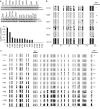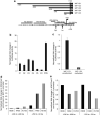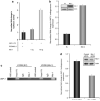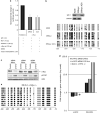Transcriptional regulation of Wnt inhibitory factor-1 by Miz-1/c-Myc
- PMID: 20697356
- PMCID: PMC3230129
- DOI: 10.1038/onc.2010.322
Transcriptional regulation of Wnt inhibitory factor-1 by Miz-1/c-Myc
Abstract
The Wnt signaling pathway is capable of self-regulation through positive and negative feedback mechanisms. For example, the oncoprotein c-Myc, which is upregulated by Wnt signaling activity, participates in a positive feedback loop of canonical Wnt signaling through repression of Wnt antagonists DKK1 and SFRP1. In this study, we investigated the mechanism of Wnt inhibitory factor-1 (WIF-1) silencing. Mapping of CpG island methylation of the WIF-1 promoter reveals regional methylation (-295 to -95 bp from the transcription start site) that correlates with transcriptional silencing. We identified Miz-1 as a direct activator of WIF-1 transcriptional activity, which is found at WIF-1 promoter. In addition, we show that c-Myc contributes to WIF-1 transcriptional repression in a Miz-1-dependent manner. Although the transient repression mediated by Miz-1/c-Myc is independent of de novo methylation, the stable repression by this complex is associated with CpG island methylation of the critical -295 to -95-bp region of the WIF-1 promoter. Importantly, Miz-1 and c-Myc are found at WIF-1 promoter in WIF-1 non-expressing cell lines DLD-1 and 209myc. Transient knockdown or somatic knockout of c-Myc in DLD-1 failed to restore WIF-1 expression suggesting that c-Myc is involved in initiating rather than maintaining WIF-1 epigenetic silencing. In a genome-wide screen, DNAJA4, TGFβ-induced and TRIM59 were repressed by c-Myc overexpression and DNA promoter hypermethylation. Our data reveal novel insights into c-Myc-mediated DNA methylation-dependent transcriptional silencing, a mechanism that might contribute to the dysregulation of Wnt signaling in cancer.
Figures







Similar articles
-
Frequent epigenetic inactivation of Wnt inhibitory factor-1 in human gastrointestinal cancers.Oncogene. 2005 Nov 24;24(53):7946-52. doi: 10.1038/sj.onc.1208910. Oncogene. 2005. PMID: 16007117
-
Epigenetic inactivation of Wnt inhibitory factor-1 plays an important role in bladder cancer through aberrant canonical Wnt/beta-catenin signaling pathway.Clin Cancer Res. 2006 Jan 15;12(2):383-91. doi: 10.1158/1078-0432.CCR-05-1344. Clin Cancer Res. 2006. PMID: 16428476
-
Wnt inhibitory factor-1 is silenced by promoter hypermethylation in human lung cancer.Cancer Res. 2004 Jul 15;64(14):4717-20. doi: 10.1158/0008-5472.CAN-04-1389. Cancer Res. 2004. PMID: 15256437
-
Promoter hypermethylation of Wnt inhibitory factor-1 in patients with lung cancer: A systematic meta-analysis.Medicine (Baltimore). 2016 Dec;95(49):e5433. doi: 10.1097/MD.0000000000005433. Medicine (Baltimore). 2016. PMID: 27930522 Free PMC article. Review.
-
Turning the tables: Myc activates Wnt in breast cancer.Cell Cycle. 2007 Nov 1;6(21):2625-7. doi: 10.4161/cc.6.21.4880. Epub 2007 Aug 13. Cell Cycle. 2007. PMID: 17726380 Review.
Cited by
-
A novel multiplex cell viability assay for high-throughput RNAi screening.PLoS One. 2011;6(12):e28338. doi: 10.1371/journal.pone.0028338. Epub 2011 Dec 5. PLoS One. 2011. PMID: 22162763 Free PMC article.
-
Genome-wide DNA methylation studies suggest distinct DNA methylation patterns in pediatric embryonal and alveolar rhabdomyosarcomas.Epigenetics. 2012 Apr;7(4):400-8. doi: 10.4161/epi.19463. Epub 2012 Apr 1. Epigenetics. 2012. PMID: 22419069 Free PMC article.
-
MYC and DNMT3A-mediated DNA methylation represses microRNA-200b in triple negative breast cancer.J Cell Mol Med. 2018 Dec;22(12):6262-6274. doi: 10.1111/jcmm.13916. Epub 2018 Oct 16. J Cell Mol Med. 2018. PMID: 30324719 Free PMC article.
-
Recognition of DNA Methylation Molecular Features for Diagnosis and Prognosis in Gastric Cancer.Front Genet. 2021 Oct 21;12:758926. doi: 10.3389/fgene.2021.758926. eCollection 2021. Front Genet. 2021. PMID: 34745226 Free PMC article.
-
Targeting Myc Interacting Proteins as a Winding Path in Cancer Therapy.Front Pharmacol. 2021 Sep 29;12:748852. doi: 10.3389/fphar.2021.748852. eCollection 2021. Front Pharmacol. 2021. PMID: 34658888 Free PMC article. Review.
References
-
- Ai L, Tao Q, Zhong S, Fields CR, Kim WJ, Lee MW, et al. Inactivation of Wnt inhibitory factor-1 (WIF1) expression by epigenetic silencing is a common event in breast cancer. Carcino-genesis. 2006;27:1341–1348. - PubMed
-
- Barr LF, Campbell SE, Diette GB, Gabrielson EW, Kim S, Shim H, et al. c-Myc suppresses the tumorigenicity of lung cancer cells and down-regulates vascular endothelial growth factor expression. Cancer Res. 2000;60:143–149. - PubMed
-
- Benanti JA, Wang ML, Myers HE, Robinson KL, Grandori C, Galloway DA. Epigenetic down-regulation of ARF expression is a selection step in immortalization of human fibroblasts by c-Myc. Mol Cancer Res. 2007;5:1181–1189. - PubMed
-
- Bowen H, Biggs TE, Phillips E, Baker ST, Perry VH, Mann DA, et al. c-Myc represses and Miz-1 activates the murine natural resistance-associated protein 1 promoter. J Biol Chem. 2002;277:34997–35006. - PubMed
Publication types
MeSH terms
Substances
Grants and funding
LinkOut - more resources
Full Text Sources
Other Literature Sources
Miscellaneous

